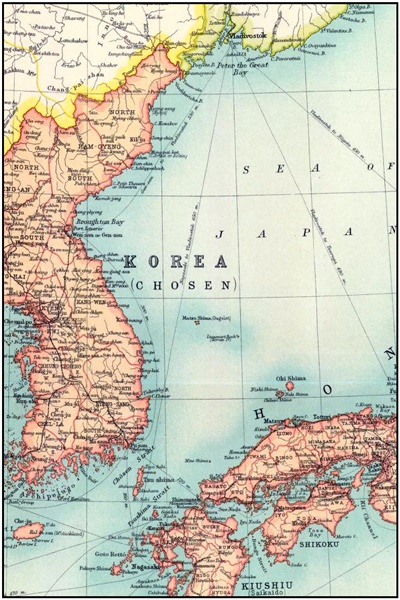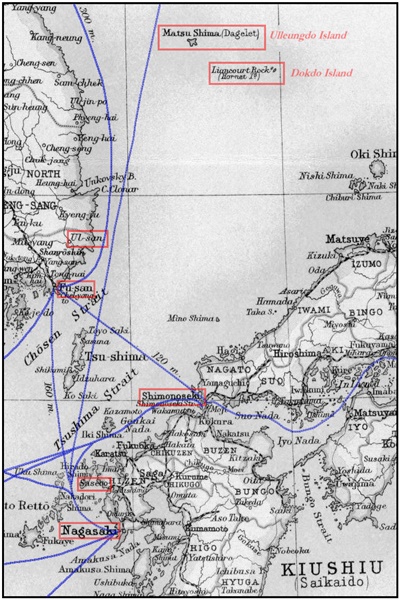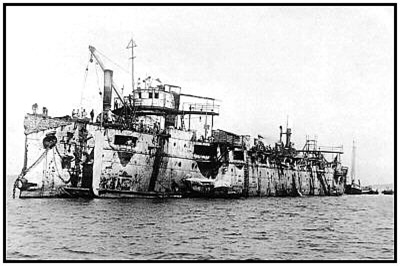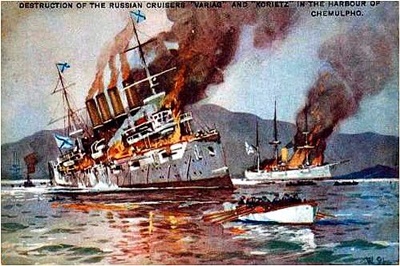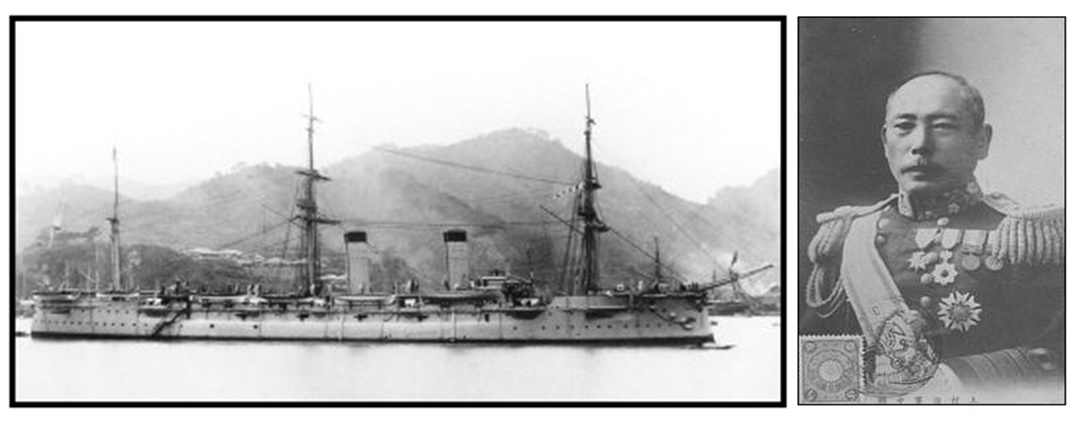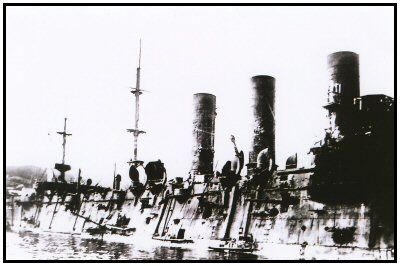At the time of the Shimane Prefecture Inclusion Japan was a nation at war, fighting for regional dominance in Northeast Asia. The waters surrounding Ulleungdo and Dokdo were the scene of fierce naval battles. The following pages detail the naval conflicts that were fought before, during and after Japan’s decision to annex Dokdo. This article will also give geographical context to Ulleungdo-Dokdo and Tsushima Islands. Through these battles can be seen Dokdo’s role in Japan’s quest for naval supremacy over the East Sea (Sea of Japan).
Below right: This map is a closeup of the waters between Korea and Japan. The shipping routes marked in blue illustrate how vital the Tsushima/Chosen Straights were.. Matsushima (Ulleungdo) and later Liancourt (Dokdo) would have military watchtowers installed to guard against the Vladivostok Fleet stationed to the North.
Matsushima (Ulleungdo Island) is located about 130kms off of Korea’s East coast and an additional 87kms East is Liancourt Rocks (Dokdo). During the Russo~Japanese war of 1904~1905 the usage of wireless radio in warfare was in its infancy, as a result much of the surveillance information was communicated via submarine telegraph lines. The need for the Japanese Navy to monitor shipping activities in the region became apparent as early as 1878. Both Ulleungdo and Dokdo’s location in the center of this busy sea lane made them strategically valuable at this time especially with telegraph submarine communications installed as an early warning system against the Russian Vladivostok Fleet attacks.
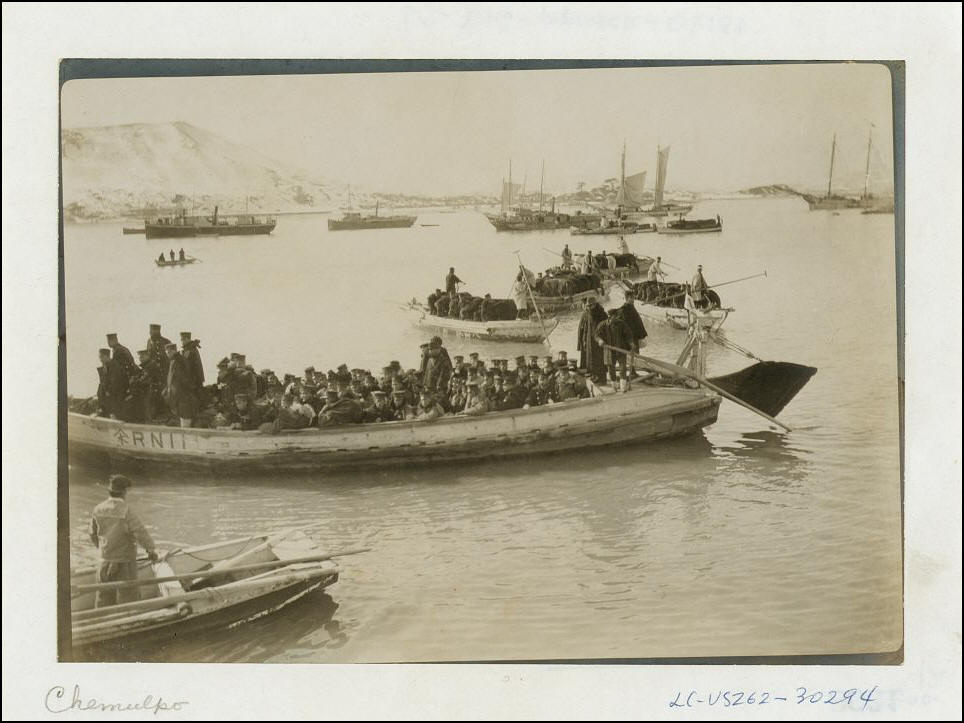 On the night of February 8 1904, the Japanese fleet under Admiral Heihachiro Togo opened the Russo-Japanese War with a surprise torpedo attack on the Russian ships at Port Arthur and badly damaged two battleships. On the same day cheering Japanese residents watched a Japanese Naval squadron-one armored cruiser, five light cruisers, and eight torpedo boats-bombard two Russian warships off Palmido Island at the mouth of Incheon Harbor in Korea.
On the night of February 8 1904, the Japanese fleet under Admiral Heihachiro Togo opened the Russo-Japanese War with a surprise torpedo attack on the Russian ships at Port Arthur and badly damaged two battleships. On the same day cheering Japanese residents watched a Japanese Naval squadron-one armored cruiser, five light cruisers, and eight torpedo boats-bombard two Russian warships off Palmido Island at the mouth of Incheon Harbor in Korea.
In the image to the left, Japanese troops land in Chemulpo (Incheon) on February 8th 1904. (Click image)
Despite all the attention it has received from historians, the attack on Port Arthur was just a covering operation for the real target of Japan’s opening move of the war, the invasion of Korea at Chemulpo. This critical operation was given to Rear Admiral Uriu Sotokichi. About seven miles up the channel from Yodolmi the Russian cruiser Varyag and gunboat Korietz were anchored.
Afterward it took Hayashi Gonsuke two weeks to manipulate cajole and intimidate the Korean leadership into signing a protocol permitting the Japanese to undertake military operations on Korean territory. The protocol signed on February 23 1904, allowed the Japanese to occupy strategic areas of Korea to achieve the territorial integrity of Korea if endangered by the aggression of a third Power or internal disturbances.
On June 15th, two important Japanese transports had sailed from Shimonoseki, each over 6,000 tons and each carrying over 1,000 men. The Hitachi Maru with a battalion of the First Reserve Regiment of the Guards was bound for Gushan, China where the base of the First Guards Brigade had been established. The Sado Maru was bound for Dalian, China with a railway battalion and electrical engineers. Both vessels also carried a large amount of stores. A third transport, the Izumi Maru of 3,200 tons, was also crossing the Tsushima Straits homeward bound with sick and wounded from the fighting front.
At 09:00 hrs the Russian Fleet had sighted the homeward bound Izumi Maru. The Russian cruiser, Gromoboi chased and opened fire and it was not till the transport had lost over 30 men, killed and wounded, that she stopped and surrendered. About 100 sick and wounded were taken off her, and then she was sunk with those who refused to surrender.
For Hitachi Maru with the Guards on board there could be no thought of surrender. As the Russian cruiser Gromoboi approached her, she turned and headed back for port under a hail of fire. The Japanese naval officer in charge was quickly killed, but the British master, John Campbell, continued on with no less determination till he too was wounded. A shell in her engine-room then killed the British chief-engineer. By this time Hitachi Maru’s decks were a shambles and she was on fire, and seeing escape was impossible Colonel Suchi who was in command of the troops solemnly destroyed the colors and then “with a smile on his face” committed suicide. The surviving men by his last orders stripped and took to the sea and of her whole company; both crew and troops, barely 150 were rescued.
The Japanese wireless transmissions had alerted Admiral Bezobrasov to the presence of Japanese Admiral Kamimura’s cruiser squadron. Thus, having dealt the Japanese a heavy blow, the Vladivostok Fleet decided to escape into the mist and rain without attempting the Western Channel of the Tsushima Straights.
The Battle of Ulsan took place on August 14th 1904 as the name suggests near the Korean coastal city of Ulsan. The fleets had closed to 8500 yards, and the Japanese ships fired first. For some reason, Japanese Admiral Kamimura in assigning targets, concentrated fire on the Rurik, the last and weakest in the Russian column. Subjected to twice the bombardment administered to her stronger comrades. Rurik lost most of her officers in a short time, and although extremely damaged, remained afloat, the diminishing number of survivors continuing to fire the few remaining guns until the very last, in a gallant display of classic heroism that won the admiration of the Japanese.
The remaining Russian cruisers tried to cover the Rurik, but with increasing damage, Admiral Essen decided at 08:30 to scuttle the Rurik, and save his other ships by heading back towards Vladivostok. Japanese cruisers chased them for some time, and firing continued, with more damage to the Russian cruisers and slight damage to the Iwate and the Azuma. The Russians were in far worse condition than the Japanese, but Admiral Kamimura then made another inexplicable decision: after pursuit of only three hours, while still on the high seas, and with long daylight steaming hours between the Russian cruisers and Vladivostok, at 11:15 hours the Japanese ceased the chase, and turned back towards Pusan.
Despite Kamimura’s failure to destroy the two remaining Russian cruisers, he was hailed as a hero in Japan, and the Vladivostok Cruiser Squadron never threatened Japanese shipping again. The Battle of Ulsan was vital in restoring Japan’s shipping lanes through the Tsushima Straight. However, as we will see, it was little more than a skirmish compared to the Battle of Tsushima fought the next year.
 The Japanese government had already decided at a cabinet meeting before the start of the war that “Korea should be placed under Japan’s influence by force under whatever circumstances,” It was the coerced Japan~Korea Protocol of February 23, 1904, that “legitimized” Japanese land appropriation for military purposes. (see link)
The Japanese government had already decided at a cabinet meeting before the start of the war that “Korea should be placed under Japan’s influence by force under whatever circumstances,” It was the coerced Japan~Korea Protocol of February 23, 1904, that “legitimized” Japanese land appropriation for military purposes. (see link)
To the right, This chart shows the East shore of Korea and West Japan. Important territories are highlighted in red. The green line indicates the initial route of naval submarine telegraph lines installed from Ulleungdo to the Japanese naval base in Sasebo . This was the first phase completed on September 2, 1904 after the Battle of Ulsan. (click image to enlarge)
After signing this unfair “treaty” Japan immediately began to construct watchtowers on both Korean coastal areas and on Matsushima (Ulleungdo Island). In Korea, these watchtowers numbered 20 and were located in Chukpyoen Bay, (Uljin) Ulsan, Keomundo and Chejudo. The Japanese built towers in parallel locations such as Kyushu and Chugoku.
Ullungdo’s two watchtowers were one at the southeastern part (East Tower with six men posted) and the other at the northwestern part (West Tower with six men posted). Their construction started on August 3, 1904, and the operation began on September 2 of the same year. The submarine cable was installed under the threat of the Vladivostok fleet and completed on September 25 of the same year. Through this cable, the watchtowers on Ullungdo were able to communicate directly with the Japanese naval base in Sasebo through the Korean mainland.
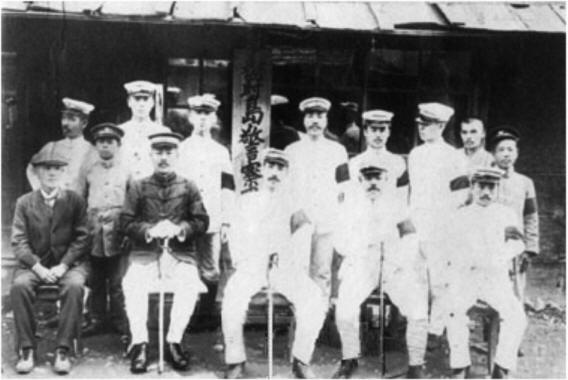 The stationing of a Japanese military force on Ulleungdo meant the further violation of Korean sovereignty over the island where the Japanese had already built its superior position. In a series of construction work on Ulleungdo as well as supply activities, and also in the course of patrol activities in these waters, a lot of information was gained about Takeshima – Dokdo. The report by the warship Niitaka was made at the time of the work to install the cable on Ulleungdo.
The stationing of a Japanese military force on Ulleungdo meant the further violation of Korean sovereignty over the island where the Japanese had already built its superior position. In a series of construction work on Ulleungdo as well as supply activities, and also in the course of patrol activities in these waters, a lot of information was gained about Takeshima – Dokdo. The report by the warship Niitaka was made at the time of the work to install the cable on Ulleungdo.
The photo to the left is of the Japanese military police officers illegally stationed on Korea’s Ulleungdo Island before and during the Russo~Japanese War of 1904~1905. Japanese military personnel were located all over the Korean peninsula during this time in areas deemed strategically important.
Japan’s military occupation of Korea was made “legal” by the coerced Japan Korea protocol signed on February 23 1904. The purpose of this treaty was to “guarantee the territorial integrity of Korea and to protect Korean independence…..(?)”
The telegraph line from Ulleungdo to Sasebo would be a great asset in controlling the East Sea (Sea of Japan) however, due to this region’s frequent foul weather Dokdo Island was necessary to extend the range of visibility for the Japanese. While Japan was in the process of drafting plans and surveying the islands of Ulleungdo and Dokdo the most significant naval battle to date would unfold in the waters surrounding these islands before they could start construction. After the Battle of Tsushima the Russian Navy would be virtually destroyed and Japan would achieve unchallenged naval supremacy in the waters of northeast Asia. The next page deals with this epic battle and the Japanese Navy’s militarization of Dokdo Island.

